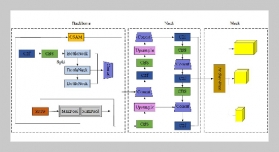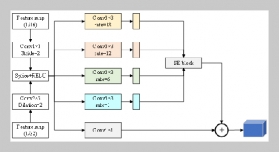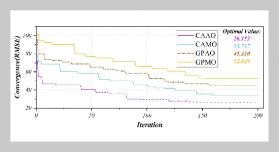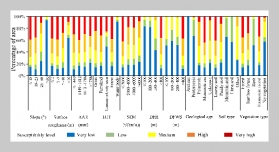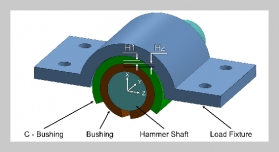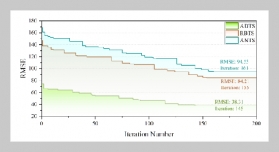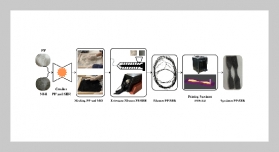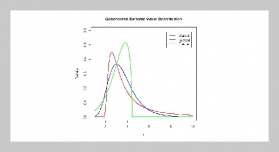- [1] T. Hasunuma and A. Kondo, (2012) “Consolidated bioprocessing and simultaneous saccharification and fermentation of lignocellulose to ethanol with thermotolerant yeast strains" Process Biochemistry 47(9): 1287–1294. DOI: 10.1016/j.procbio.2012.05.004.
- [2] Y.-S. Cheng, P. Mutrakulcharoen, S. Chuetor, K. Cheenkachorn, P. Tantayotai, E. J. Panakkal, and M. Sriariyanun, (2020) “Recent situation and progress in biorefining process of lignocellulosic biomass: Toward green economy" Applied Science and Engineering Progress 13(4): 299–311. DOI: 10.14416/j.asep.2020. 08.002.
- [3] M. P. Gundupalli and M. Sriariyanun, (2022) “Recent trends and updates for chemical pretreatment of lignocellulosic biomass" Appl. Sci. Eng. Prog 16: 5842. DOI: 10.14416/j.asep.2022.03.002.
- [4] T. Raj, K. Chandrasekhar, A. N. Kumar, J. R. Banu, J.-J. Yoon, S. K. Bhatia, Y.-H. Yang, S. Varjani, and S.-H. Kim, (2022) “Recent advances in commercial biorefineries for lignocellulosic ethanol production: Current status, challenges and future perspectives" Bioresource technology 344: 126292. DOI: 10.1016/j.biortech.2021.126292.
- [5] J. Qiao, H. Cui, M. Wang, X. Fu, X. Wang, X. Li, and H. Huang, (2022) “Integrated biorefinery approaches for the industrialization of cellulosic ethanol fuel" Bioresource Technology: 127516. DOI: 10.1016/j.biortech.2022.127516.
- [6] L. G. Nair, K. Agrawal, and P. Verma, (2022) “An insight into the principles of lignocellulosic biomass-based zero-waste biorefineries: a green leap towards imperishable energy-based future" Biotechnology and Genetic Engineering Reviews: 1–51. DOI: 10.1080/02648725.2022.2082223.
- [7] A. M. Borrero-Lopez, C. Valencia, and J. Franco, (2022) “Lignocellulosic materials for the production of biofuels, biochemicals and biomaterials and applications of lignocellulose-based polyurethanes: a review" Polymers 14(5): 881. DOI: 10.3390/polym14050881.
- [8] H. Guo, Y. Zhao, J.-S. Chang, and D.-J. Lee, (2022) “Inhibitor formation and detoxification during lignocellulose biorefinery: A review" Bioresource Technology: 127666. DOI: 10.1016/j.biortech.2022.127666.
- [9] B. A. Brandt, T. Jansen, J. F. Görgens, and W. H. van Zyl, (2019) “Overcoming lignocellulose-derived microbial inhibitors: advancing the Saccharomyces cerevisiae resistance toolbox" Biofuels, Bioproducts and Biorefining 13(6): 1520–1536. DOI: 10.1002/bbb.2042.
- [10] S.-J. Ha, J. M. Galazka, S. Rin Kim, J.-H. Choi, X. Yang, J.-H. Seo, N. Louise Glass, J. H. Cate, and Y.-S. Jin, (2011) “Engineered Saccharomyces cerevisiae capable of simultaneous cellobiose and xylose fermentation" Proceedings of the National Academy of Sciences 108(2): 504–509. DOI: 10.1073/pnas.1010456108.
- [11] T. W. Jeffries and Y.-S. Jin, (2000) “Ethanol and thermotolerance in the bioconversion of xylose by yeasts": DOI: DOI:10.1016/S0065-2164(00)47006-1.
- [12] A. Duque, C. Álvarez, P. Doménech, P. Manzanares, and A. D. Moreno, (2021) “Advanced bioethanol production: From novel raw materials to integrated biorefineries" Processes 9(2): 206.
- [13] Z. Ahmad, W. W. Al Dajani, M. Paleologou, and C. Xu, (2020) “Sustainable process for the depolymerization/oxidation of softwood and hardwood kraft lignins using hydrogen peroxide under ambient conditions" Molecules 25(10): 2329. DOI: 10.3390/molecules25102329.
- [14] J.-M. Lavoie, R. Beauchet, V. Berberi, and M. Chornet. “Biorefining lignocellulosic biomass via the feedstock impregnation rapid and sequential steam treatment”. In: Biofuel’s Engineering Process Technology. IntechOpen, 2011. DOI: 10.5772/18186.
- [15] D. Jose, C. Muenmuang, N. Kitiborwornkul, P. Yasurin, S. Asavasanti, P. Tantayotai, and M. Sriariyanun, (2022) “Effect of surfactants and Co-surfactants in formulation of noni fruit extract in virgin coconut oil-based emulsion" Journal of the Indian Chemical Society 99(10): 100729.
- [16] L. Zhao, Z.-F. Sun, C.-C. Zhang, J. Nan, N.-Q. Ren, D.-J. Lee, and C. Chen, (2022) “Advances in pretreatment of lignocellulosic biomass for bioenergy production: Challenges and perspectives" Bioresource Technology 343: 126123. DOI: 10.1016/j.biortech.2021.126123.
- [17] Y.-S. Cheng, Z.-Y. Wu, and M. Sriariyanun, (2019) “Evaluation of Macaranga tanarius as a biomass feedstock for fermentable sugars production" Bioresource technology 294: 122195. DOI: 10.1016/j.biortech.2019.122195.
- [18] S. Sharma, E. Varghese, A. Arora, K. Singh, S. Singh, L. Nain, and D. Paul, (2018) “Augmenting pentose utilization and ethanol production of native Saccharomyces cerevisiae LN using medium engineering and response surface methodology" Frontiers in Bioengineering and Biotechnology 6: 132.
- [19] E. J. Panakkal, M. Sriariyanun, J. Ratanapoompinyo, P. Yasurin, K. Cheenkachorn, W. Rodiahwati, and P. Tantayotai, (2022) “Influence of sulfuric acid pretreatment and inhibitor of sugarcane bagasse on the production of fermentable sugar and ethanol" Applied Science and Engineering Progress 15(1): DOI: 10.14416/j.asep. 2021.07.006.
- [20] J. Sharma, V. Kumar, R. Prasad, and N. A. Gaur, (2022) “Engineering of Saccharomyces cerevisiae as a consolidated bioprocessing host to produce cellulosic ethanol: Recent advancements and current challenges" Biotechnology Advances: 107925. DOI: 10.1016/j.biotechadv.2022.107925.
- [21] T. H. Kim, R. Gupta, and Y. Lee, (2009) “Pretreatment of biomass by aqueous ammonia for bioethanol production" Biofuels: methods and protocols: 79–91. DOI: 10.1007/978-1-60761-214-8_6.
- [22] W. H. Van Zyl, L. R. Lynd, R. den Haan, and J. E. McBride, (2007) “Consolidated bioprocessing for bioethanol production using Saccharomyces cerevisiae" Biofuels: 205–235. DOI: 10.1007/10_2007_061.
- [23] H. Zabed, J. Sahu, A. N. Boyce, and G. Faruq, (2016) “Fuel ethanol production from lignocellulosic biomass: an overview on feedstocks and technological approaches" Renewable and sustainable energy reviews 66: 751–774. DOI: 10.1016/j.rser.2016.08.038.
- [24] L. Peng and Y. Chen, (2011) “Conversion of paper sludge to ethanol by separate hydrolysis and fermentation (SHF) using Saccharomyces cerevisiae" Biomass and Bioenergy 35(4): 1600–1606. DOI: 10.1016/j.biombioe.2011.01.059.
- [25] M. P. Coughlan, (1985) “The properties of fungal and bacterial cellulases with comment on their production and application" Biotechnology and genetic engineering reviews 3(1): 39–110. DOI: 10.1080/02648725.1985.10647809.
- [26] M. Parapouli, A. Vasileiadis, A.-S. Afendra, and E. Hatziloukas, (2020) “Saccharomyces cerevisiae and its industrial applications" AIMS microbiology 6(1): 1. DOI: 10.3934/microbiol.2020001.
- [27] M. A. Tesfay, X. Win, H. Lin, Y. Liu, C. Li, J. Lin, and J. Lin, (2021) “Efficient L-xylulose production using wholecell biocatalyst with NAD+ regeneration system through co-expression of xylitol dehydrogenase and NADH oxidase in Escherichia coli" Biochemical Engineering Journal 175: 108137.
- [28] N. K. Sharma, S. Behera, R. Arora, S. Kumar, and R. K. Sani, (2018) “Xylose transport in yeast for lignocellulosic ethanol production: current status" Journal of bioscience and bioengineering 125(3): 259–267. DOI: 10.1016/j.jbiosc.2017.10.006.
- [29] J. T. Cunha, P. O. Soares, S. L. Baptista, C. E. Costa, and L. Domingues, (2020) “Engineered Saccharomyces cerevisiae for lignocellulosic valorization: a review and perspectives on bioethanol production" Bioengineered 11(1): 883–903. DOI: 10.1080/21655979.2020.1801178.
- [30] M. Toor, S. S. Kumar, S. K. Malyan, N. R. Bishnoi, T. Mathimani, K. Rajendran, and A. Pugazhendhi, (2020) “An overview on bioethanol production from lignocellulosic feedstocks" Chemosphere 242: 125080. DOI: 10.1016/j.chemosphere.2019.125080.
- [31] J. M. Fox, S. E. Levine, H. W. Blanch, and D. S. Clark, (2012) “An evaluation of cellulose saccharification and fermentation with an engineered Saccharomyces cerevisiae capable of cellobiose and xylose utilization" Biotechnology Journal 7(3): 361–373. DOI: 10.1002/biot.201100209.
- [32] V. Rana, A. D. Eckard, and B. K. Ahring, (2014) “Comparison of SHF and SSF of wet exploded corn stover and loblolly pine using in-house enzymes produced from T. reesei RUT C30 and A. saccharolyticus" SpringerPlus 3: 1–13. DOI: 10.1186/2193-1801-3-516.
- [33] D. Dahnum, S. O. Tasum, E. Triwahyuni, M. Nurdin, and H. Abimanyu, (2015) “Comparison of SHF and SSF processes using enzyme and dry yeast for optimization of bioethanol production from empty fruit bunch" Energy Procedia 68: 107–116. DOI: 10.1016/j.egypro.2015.03.238.
- [34] F. Alfani, A. Gallifuoco, A. Saporosi, A. Spera, and M. Cantarella, (2000) “Comparison of SHF and SSF processes for the bioconversion of steam-exploded wheat straw" Journal of Industrial Microbiology and Biotechnology 25(4): 184–192. DOI: 10.1038/sj.jim.7000054.
- [35] H. Kawaguchi, T. Hasunuma, C. Ogino, and A. Kondo, (2016) “Bioprocessing of bio-based chemicals produced from lignocellulosic feedstocks" Current opinion in biotechnology 42: 30–39. DOI: 10.1016/j.copbio.2016.02.031.
- [36] K. Olofsson, B. Palmqvist, and G. Lidén, (2010) “Improving simultaneous saccharification and cofermentation of pretreated wheat straw using both enzyme and substrate feeding" Biotechnology for biofuels 3: 1–9. DOI: 10.1186/1754-6834-3-17.
- [37] Z.-H. Liu and H.-Z. Chen, (2016) “Simultaneous saccharification and co-fermentation for improving the xylose utilization of steam exploded corn stover at high solid loading" Bioresource technology 201: 15–26. DOI: 10.1016/j.biortech.2015.11.023.
- [38] J.-Q. Zhu, Q.-J. Zong, W.-C. Li, M.-Z. Chai, T. Xu, H. Liu, H. Fan, B.-Z. Li, and Y.-J. Yuan, (2020) “Temperature profiled simultaneous saccharification and cofermentation of corn stover increases ethanol production at high solid loading" Energy Conversion and Management 205: 112344.
- [39] L. R. Lynd, W. H. Van Zyl, J. E. McBride, and M. Laser, (2005) “Consolidated bioprocessing of cellulosic biomass: an update" Current opinion in biotechnology 16(5): 577–583. DOI: 10.1016/j.copbio.2005.08.009.
- [40] Y. Liu, X. Xie, W. Liu, H. Xu, and Y. Cao, (2020) “Consolidated bioprocess for bioethanol production from lignocellulosic biomass using Clostridium thermocellum DSM 1237" BioResources 15(4): 8355. DOI: 10.15376/biores.15.4.8355-8368.
- [41] A. Althuri, L. K. S. Gujjala, and R. Banerjee, (2017) “Partially consolidated bioprocessing of mixed lignocellulosic feedstocks for ethanol production" Bioresource Technology 245: 530–539. DOI: 10.1016/j.biortech.2017.08.140.
- [42] S. Vaid, S. Sharma, H. C. Dutt, R. Mahajan, and B. K. Bajaj, (2021) “One pot consolidated bioprocess for conversion of Saccharum spontaneum biomass to ethanolbiofuel" Energy Conversion and Management 250: 114880. DOI: 10.1016/j.enconman.2021.114880.
- [43] L. Chen, J.-L. Du, Y.-J. Zhan, J.-A. Li, R.-R. Zuo, and S. Tian, (2018) “Consolidated bioprocessing for cellulosic ethanol conversion by cellulase–xylanase cellsurfaced yeast consortium" Preparative Biochemistry and Biotechnology 48(7): 653–661. DOI: 10.1080/10826068.2018.1487846.
- [44] L. R. Lynd, X. Liang, M. J. Biddy, A. Allee, H. Cai, T. Foust, M. E. Himmel, M. S. Laser, M. Wang, and C. E. Wyman, (2017) “Cellulosic ethanol: status and innovation" Current opinion in biotechnology 45: 202–211.
- [45] A. Joshi, K. K. Verma, V. D Rajput, T. Minkina, and J. Arora, (2022) “Recent advances in metabolic engineering of microorganisms for advancing lignocellulose-derived biofuels" Bioengineered 13(4): 8135–8163.
- [46] S. Kirdponpattara, S. Chuetor, M. Sriariyanun, and M. Phisalaphong, (2022) “Bioethanol Production by Pichia stipitis Immobilized on Water Hyacinth and Thinshell Silk Cocoon" Applied Science and Engineering Progress 15(3): 4662–4662. DOI: 10.14416/j.asep.2021.03.006.
- [47] S. Lane, J. Dong, and Y.-S. Jin, (2018) “Value-added biotransformation of cellulosic sugars by engineered Saccharomyces cerevisiae" Bioresource technology 260: 380–394.
- [48] M. Taha, M. Foda, E. Shahsavari, A. Aburto-Medina, E. Adetutu, and A. Ball, (2016) “Commercial feasibility of lignocellulose biodegradation: possibilities and challenges" Current Opinion in Biotechnology 38: 190–197.
- [49] M. Broda, D. J. Yelle, and K. Serwa´nska, (2022) “Bioethanol Production from Lignocellulosic Biomass—Challenges and Solutions" Molecules 27(24): 8717.
- [50] Z. Yao, Q. Wang, and Z. Dai, (2022) “Recent advances in directed yeast genome evolution" Journal of Fungi 8(6): 635. DOI: 10.3390/jof8060635.
- [51] Y. A. Menegon, J. Gross, and A. P. Jacobus, (2022) “How adaptive laboratory evolution can boost yeast tolerance to lignocellulosic hydrolyses" Current Genetics 68(3-4): 319–342. DOI: 10.1007/s00294-022-01237-z.
- [52] A. P. Jacobus, J. Gross, J. H. Evans, S. R. CeccatoAntonini, and A. K. Gombert, (2021) “Saccharomyces cerevisiae strains used industrially for bioethanol production" Essays in Biochemistry 65(2): 147–161. DOI: 10.1002/biot.202000142.
- [53] A. P. Jacobus, J. Gross, J. H. Evans, S. R. CeccatoAntonini, and A. K. Gombert, (2021) “Saccharomyces cerevisiae strains used industrially for bioethanol production" Essays in Biochemistry 65(2): 147–161. DOI: 10.1042/EBC20200160.
- [54] J. Sharma, V. Kumar, R. Prasad, and N. A. Gaur, (2022) “Engineering of Saccharomyces cerevisiae as a consolidated bioprocessing host to produce cellulosic ethanol: Recent advancements and current challenges" Biotechnology Advances: 107925.
- [55] D. P. Procópio, E. Kendrick, R. Goldbeck, A. R. d. L. Damasio, T. T. Franco, D. J. Leak, Y.-S. Jin, and T. O. Basso, (2022) “Xylo-Oligosaccharide Utilization by Engineered Saccharomyces cerevisiae to Produce Ethanol" Frontiers in Bioengineering and Biotechnology 10: 105. DOI: 10.3389/fbioe.2022.825981.
- [56] A. Madhavan, K. Arun, R. Sindhu, B. G. Nair, A. Pandey, M. K. Awasthi, G. Szakacs, and P. Binod, (2022) “Design and genome engineering of microbial cell factories for efficient conversion of lignocellulose to fuel" Bioresource Technology: 128555.
- [57] F. Maleki, M. Changizian, N. Zolfaghari, S. Rajaei, K. A. Noghabi, and H. S. Zahiri, (2021) “Consolidated bioprocessing for bioethanol production by metabolically engineered Bacillus subtilis strains" Scientific Reports 11(1): 13731. DOI: 10.1038/s41598-021-92627-9.
- [58] E. Guedon, M. Desvaux, and H. Petitdemange, (2002) “Improvement of cellulolytic properties of Clostridium cellulolyticum by metabolic engineering" Applied and environmental microbiology 68(1): 53–58. DOI: 10.1128/AEM.68.1.53-58.2002.
- [59] S. Hon, D. G. Olson, E. K. Holwerda, A. A. Lanahan, S. J. Murphy, M. I. Maloney, T. Zheng, B. Papanek, A. M. Guss, and L. R. Lynd, (2017) “The ethanol pathway from Thermoanaerobacterium saccharolyticum improves ethanol production in Clostridium thermocellum" Metabolic engineering 42: 175–184. DOI: 10.1016/j.ymben.2017.06.011.
- [60] R. Biswas, S. Prabhu, L. R. Lynd, and A. M. Guss, (2014) “Increase in ethanol yield via elimination of lactate production in an ethanol-tolerant mutant of Clostridium thermocellum" PLoS One 9(2): e86389. DOI: 10.1371/journal.pone.0086389.
- [61] S. Kannuchamy, N. Mukund, and L. M. Saleena, (2016) “Genetic engineering of Clostridium thermocellum DSM1313 for enhanced ethanol production" BMC biotechnology 16(1): 1–6. DOI: 10.1186/s12896-016-0260-2.
- [62] B. Dien, R. Hespell, L. Ingram, and R. Bothast, (1997) “Conversion of corn milling fibrous co-products into ethanol by recombinant Escherichia coli strains K011 and SL40" World Journal of Microbiology and Biotechnology 13: 619–625. DOI: 10.1023/A:1018554417934.
- [63] C. Dong, J. Qiao, X. Wang, W. Sun, L. Chen, S. Li, K. Wu, L. Ma, and Y. Liu, (2020) “Engineering Pichia pastoris with surface-display minicellulosomes for carboxymethyl cellulose hydrolysis and ethanol production" Biotechnology for biofuels 13(1): 1–9. DOI: 10.1186/s13068-020-01749-1.
- [64] S. Yanase, T. Hasunuma, R. Yamada, T. Tanaka, C. Ogino, H. Fukuda, and A. Kondo, (2010) “Direct ethanol production from cellulosic materials at high temperature using the thermotolerant yeast Kluyveromyces marxianus displaying cellulolytic enzymes" Applied Microbiology and Biotechnology 88: 381–388. DOI: 10.1007/s00253-010-2784-z.
- [65] B. He, B. Hao, H. Yu, F. Tu, X. Wei, K. Xiong, Y. Zeng, H. Zeng, P. Liu, Y. Tu, et al., (2022) “Double integrating XYL2 into engineered Saccharomyces cerevisiae strains for consistently enhanced bioethanol production by effective xylose and hexose co-consumption of steam-exploded lignocellulose in bioenergy crops" Renewable Energy 186: 341–349. DOI: 10.1016/j.renene.2021.12.103.
- [66] R. A. Cripwell, S. H. Rose, L. Favaro, and W. H. Van Zyl, (2019) “Construction of industrial Saccharomyces cerevisiae strains for the efficient consolidated bioprocessing of raw starch" Biotechnology for biofuels 12: 1–16. DOI: 10.1186/s13068-019-1541-5.
- [67] J. K. Ko, Y. Um, H. M. Woo, K. H. Kim, and S.-M. Lee, (2016) “Ethanol production from lignocellulosic hydrolysates using engineered Saccharomyces cerevisiae harboring xylose isomerase-based pathway" Bioresource Technology 209: 290–296. DOI: 10.1016/j.biortech.2016.02.124.
- [68] J. T. Cunha, T. Q. Aguiar, A. Romanı, C. Oliveira, and L. Domingues, (2015) “Contribution of PRS3, RPB4 and ZWF1 to the resistance of industrial Saccharomyces cerevisiae CCUG53310 and PE-2 strains to lignocellulosic hydrolysate-derived inhibitors" Bioresource Technology 191: 7–16. DOI: 10.1016/j.biortech.2015.05.006.
- [69] E. J. Oh, N. Wei, S. Kwak, H. Kim, and Y.-S. Jin, (2019) “Overexpression of RCK1 improves acetic acid tolerance in Saccharomyces cerevisiae" Journal of Biotechnology 292: 1–4. DOI: 10.1016/j.jbiotec.2018.12.013.
- [70] J. T. Cunha, C. E. Costa, L. Ferraz, A. Romanı, B. Johansson, I. Sá-Correia, and L. Domingues, (2018) “HAA1 and PRS3 overexpression boosts yeast tolerance towards acetic acid improving xylose or glucose consumption: unravelling the underlying mechanisms" Applied microbiology and biotechnology 102: 4589–4600. DOI: 10.1007/s00253-018-8955-z.
- [71] H.-S. Kim, N.-R. Kim, J. Yang, and W. Choi, (2011) “Identification of novel genes responsible for ethanol and/or thermotolerance by transposon mutagenesis in Saccharomyces cerevisiae" Applied microbiology and biotechnology 91: 1159–1172. DOI: 10.1007/s00253-011-3298-z.
- [72] K. Deanda, M. Zhang, C. Eddy, and S. Picataggio, (1996) “Development of an arabinose-fermenting Zymomonas mobilis strain by metabolic pathway engineering" Applied and Environmental Microbiology 62(12): 4465–4470. DOI: 10.1128/aem.62.12.4465-4470.1996.
- [73] M. Zhang, C. Eddy, K. Deanda, M. Finkelstein, and S. Picataggio, (1995) “Metabolic engineering of a pentose metabolism pathway in ethanologenic Zymomonas mobilis" Science 267(5195): 240–243. DOI: 10.1126/science.267.5195.240.
- [74] E. Joachimsthal, K. D. Haggett, and P. L. Rogers. “Evaluation of recombinant strains of Zymomonas mobilis for ethanol production from glucose/xylose media”. In: Twentieth Symposium on Biotechnology for Fuels and Chemicals: Presented as Volumes 77–79 of Applied Biochemistry and Biotechnology Proceedings of the Twentieth Symposium on Biotechnology for Fuels and Chemicals Held May 3–7, 1998, Gatlinburg, Tennessee. Springer. 1999, 147–157.
- [75] S. R. Kim, Y.-C. Park, Y.-S. Jin, and J.-H. Seo, (2013) “Strain engineering of Saccharomyces cerevisiae for enhanced xylose metabolism" Biotechnology advances 31(6): 851–861. DOI: 10.1016/j.biotechadv.2013.03.004.
- [76] Y.-S. Jin, H. Ni, J. M. Laplaza, and T. W. Jeffries, (2003) “Optimal growth and ethanol production from xylose by recombinant Saccharomyces cerevisiae require moderate D-xylulokinase activity" Applied and environmental Microbiology 69(1): 495–503. DOI: 10.1128/AEM.69.1.495-503.2003.
- [77] J. Lou, J. Wang, Y. Yang, Q. Yang, R. Li, M. Hu, Q. He, J. Du, X. Wang, M. Li, et al., (2021) “Development and characterization of efficient xylose utilization strains of Zymomonas mobilis" Biotechnology for biofuels 14(1): 1–18. DOI: 10.1186/s13068-021-02082-x.
- [78] Y.-J. Liu, B. Li, Y. Feng, and Q. Cui, (2020) “Consolidated bio-saccharification: Leading lignocellulose bioconversion into the real world" Biotechnology advances 40: 107535. DOI: 10.1016/j.biotechadv.2020.107535.
- [79] R. Yamada, T. Hasunuma, and A. Kondo, (2013) “Endowing non-cellulolytic microorganisms with cellulolytic activity aiming for consolidated bioprocessing" Biotechnology advances 31(6): 754–763. DOI: 10.1016/j.biotechadv.2013.02.007.
- [80] D. G. Olson, J. E. McBride, A. J. Shaw, and L. R. Lynd, (2012) “Recent progress in consolidated bioprocessing" Current opinion in biotechnology 23(3): 396–405. DOI: 10.1016/j.copbio.2011.11.026.
- [81] W.-H. Lee and Y.-S. Jin, (2017) “Improved ethanol production by engineered Saccharomyces cerevisiae expressing a mutated cellobiose transporter during simultaneous saccharification and fermentation" Journal of biotechnology 245: 1–8. DOI: 10.1016/j.jbiotec.2017.01.018.
- [82] A. Madhavan, K. Arun, R. Sindhu, J. Krishnamoorthy, R. Reshmy, R. Sirohi, A. Pugazhendi, M. K. Awasthi, G. Szakacs, and P. Binod, (2021) “Customized yeast cell factories for biopharmaceuticals: From cell engineering to process scale up" Microbial Cell Factories 20(1): 124. DOI: 10.1186/s12934-021-01617-z.
- [83] B. Chen, H. L. Lee, Y. C. Heng, N. Chua, W. S. Teo, W. J. Choi, S. S. J. Leong, J. L. Foo, and M. W. Chang, (2018) “Synthetic biology toolkits and applications in Saccharomyces cerevisiae" Biotechnology advances 36(7): 1870–1881. DOI: 10.1016/j.biotechadv.2018.07.005.
- [84] J. T. Cunha, D. G. Gomes, A. Romani, K. Inokuma, T. Hasunuma, A. Kondo, and L. Domingues, (2021) “Cell surface engineering of Saccharomyces cerevisiae for simultaneous valorization of corn cob and cheese whey via ethanol production" Energy Conversion and Management 243: 114359. DOI: 10.1016/j.enconman.2021.114359.
- [85] E. Gnansounou and A. Dauriat, (2010) “Technoeconomic analysis of lignocellulosic ethanol: a review" Bioresource technology 101(13): 4980–4991. DOI: 10.1016/j.biortech.2010.02.009.
- [86] M. Galbe, P. Sassner, A. Wingren, and G. Zacchi, (2007) “Process engineering economics of bioethanol production" Biofuels: 303–327. DOI: 10.1007/10_2007_063.
- [87] F. C. Barba, R. M. Rodrıguez-Jasso, R. K. Sukumaran, H. A. Ruiz, et al., (2022) “High-solids loading processing for an integrated lignocellulosic biorefinery: Effects of transport phenomena and rheology–A review" Bioresource Technology: 127044. DOI: 10.1016/j.biortech.2022.127044.
- [88] H. J. Kadhum and G. S. Murthy, (2022) “Novel system design for high solid lignocellulosic biomass conversion" Bioresource Technology 350: 126897.
- [89] A. S. da Silva, R. P. Espinheira, R. S. S. Teixeira, M. F. de Souza, V. Ferreira-Leitao, and E. P. Bon, (2020) “Constraints and advances in high-solids enzymatic hydrolysis of lignocellulosic biomass: a critical review" Biotechnology for Biofuels 13(1): 1–28. DOI: 10.1186/s13068- 020-01697-w.
- [90] S. Chuetor, E. J. Panakkal, T. Ruensodsai, K. Cheenkachorn, S. Kirdponpattara, Y.-S. Cheng, and M. Sriariyanun, (2022) “Improvement of enzymatic saccharification and ethanol production from rice straw using recycled ionic liquid: The effect of anti-solvent mixture" Bioengineering 9(3): 115. DOI: 10.3390/bioengineering9030115.
- [91] M. Sriariyanun, N. Kitiborwornkul, P. Tantayotai, K. Rattanaporn, and P.-L. Show, (2022) “One-pot ionic liquid-mediated bioprocess for pretreatment and enzymatic hydrolysis of rice straw with ionic liquid-tolerance bacterial cellulase" Bioengineering 9(1): 17. DOI: 10.3390/bioengineering9010017.
- [92] C. Turnbull, M. Lillemo, and T. A. Hvoslef-Eide, (2021) “Global regulation of genetically modified crops amid the gene edited crop boom–a review" Frontiers in Plant Science 12: 630396. DOI: 10.3389/fpls.2021.630396.



